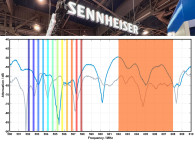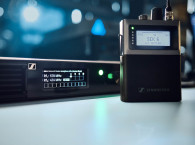
According to Sebastian Georgi, "With this technology, we are re-thinking wireless transmission in multichannel applications such as big live events, theaters, and broadcast studios – wherever many audio channels are up in the air. Sennheiser’s implementation of WMAS is essentially a bi-directional wireless broadband technology, which combines microphones, in-ears, and remote control in just one broadband RF channel.
"When we started out with this development project, our original intention was to combat RF fading, the natural signal loss on stages. RF fading can cause signal dropouts, which is what makes every sound engineer’s job so difficult. By finding ways to better exploit the diversity offered by the broadband RF channel, we wanted to eliminate the risk of signal dropouts.
"In addition, we aimed to simplify set-up for the user, acknowledging the fact that narrowband wireless systems require quite complex stage set-ups, especially in multi-channel applications.
"Another goal was to make better use of the scarce frequency resources, an ever-increasing challenge that audio engineers are faced with,” he summarizes.
Jan Watermann details the differences in this broadband approach compared to today’s wireless microphone systems. "Jan: “Today’s wireless audio technology relies on narrowband RF solutions, with one transmitter sending signals to one receiver unit. And, unfortunately, the transmitter cannot notice whether ‘its’ receiver has been switched on or not, or whether it is out of range. In a figurative sense, you could say that every microphone, once configured, is fighting on its own.
"Broadband wireless technology, on the other hand, is system-based, a cooperative approach, as it were. Many mobile devices are linked over the air with one rack-mount unit. Now, everything happens in a single broadband RF channel with a bandwidth of 6 or 8MHz, the bandwidth of a TV channel. The audio engineer simply selects a carrier frequency for the broadband RF channel to be configured, and the system will coordinate itself, with the quality and range that the engineer chooses for the individual audio devices.

Martin Brandenburg details further how this solution can save precious frequency resources. "Just bear in mind that WMAS is designed for multichannel audio applications that integrate wireless microphones, in-ear monitors, remote control, and other audio applications into one radio interface. This brings significant efficiencies in spectrum use – not just by technology, but also by enabling workflow improvements. These wins can be invested in flexibility and audio quality. For example, IEMs and microphones, which today are split between two RF ranges that are several MHz apart, can now be handled together in a single TV channel, which, in addition, makes frequency planning a breeze. But to be clear, narrowband, 200kHz digital wireless microphones will continue to be used for applications where this integration is not required, or where only a few mics are used."
"Secondly, our system will operate with a total of 50mW of transmit power per RF broadband channel, which is the transmit power of a single microphone today. Within the capacity limit of the system, there will no longer be any scaling of the total transmit power by the number of devices used. Furthermore, this transmission power will be distributed over the entire RF broadband channel, so the spectral power density is lower by a factor of 30 (6MHz) or 40 (8MHz) compared to a single wireless microphone with a bandwidth of 200kHz. This low spectral power density means that an RF channel can be reused more easily. This would, for example, be an asset in multi-studio broadcast production facilities or on the different stages of a spacious festival site.

Detailing further the benefits for the broadband approach, Martin Brandenburg states: "Last but not least, our approach allows remote control of all equipment at all times, and also the allocation of resources to equipment as really needed at any given time. This makes it possible to save spectrum by employing a new workflow where the audio engineer can schedule resources on a timeline. Compared to today, where all devices would be actively transmitting at the same high quality all the time, this new workflow would mean a substantial gain in spectral efficiency at large events.
"Overall, the Sennheiser solution will enable customers to significantly reduce their spectrum footprint while gaining unmatched integration, audio quality, low-latency transmission, control, and flexibility in their applications."
Andreas Wilzeck also remarks that "It is worth noting that the number and complexity of large events and mega-events is continuously increasing, and the associated demand for radio spectrum is too. This is not just statistics – securing enough spectrum for these big events is increasingly causing engineers and event organizers a headache, especially with outdoor events. The WMAS solution will certainly help."
Regarding the required regulatory approval for this new approach, which requires rising the currently stipulated 200kHz maximum RF transmission bandwidth limit, Andreas Wilzeck reveals that "The relevant harmonized standard EN 300 422-1 for wireless microphones was amended in 2017 to take wireless multi-channel audio systems (WMAS) into account. This EN 300 422-1 standard is referenced more or less worldwide in the national regulations for the market access of wireless microphones.
"We successfully initiated the necessary regulatory changes some years ago; they have already been implemented in many countries in EMEA and APAC. The process in the US is not yet complete, but we are confident that WMAS will soon be possible here, too. The availability of products based on this breakthrough technology will naturally accelerate regulatory changes on a global scale, because after all, no country wants to get left behind."
Sennheiser also confirms that future WMAS systems will operate in the same frequencies as those of today’s narrowband systems. According to Wilzeck, the Sennheiser WMAS solution will operate in co-existence in the standard UHF frequency ranges for wireless microphones. "No changes to the transmission power limits are required. It was just the bandwidth limit that had to be removed or lifted to at least 6MHz."

Martin Brandenburg also explains that Sennheiser decided earlier that the new WMAS systems will deliver on all the strict requirements for live sound applications, in terms of latency, operational reliability, number of channels, and audio quality.
"We have already mentioned the improved use of spectrum resources by the new workflows that become possible through WMAS, and the flexibility that the system offers for larger premises or festival grounds thanks to its lower spectral power density," adds Jan Watermann. "In addition, combined, bi-directional bodypacks including low-latency, true digital in-ear monitoring will be possible – bands and artists will just need one device instead of two. Mic transmission, in-ear monitoring, and permanent remote control will all happen via the same device in a single RF channel. Also, the sound engineer will be able to flexibly select the audio quality, latency, range, and resource occupation for every single audio transmission of the devices. Furthermore, all mobile devices will be perfectly synchronized, enabling wireless stereo and even 3D audio recording without any audio phase issues."
Adding further Sebastian Georgi describes: "The backstage tech space will look very different, as WMAS will allow our customers to have the processing of 64 audio channels done by a single 19"/1U rack-mount unit! Gone will be the days of receiver cabinets – our customers will save backstage space, valuable truck space on tour and thus energy, too. Except for selecting a single RF channel, extensive frequency planning will not be required. If we want to come full circle, we can look at the RF fading challenge we set out to solve in the beginning: Instead of today’s typical spatial diversity with two antennas, WMAS will offer 30-fold diversity in a 6MHz TV channel or 40-fold diversity in an 8MHz TV channel – with a single antenna!"
Sennheiser also confirms that today's narrowband wireless microphones and in-ears will be able to co-exist with broadband wireless multi-channel audio systems and that the company has already performed tests that will be detailed further when WMAS systems will become available. For now, Sennheiser has created a dedicated WMAS page on its website and a dedicated WMAS newsletter that will update anyone interested in the new technology.
www.sennheiser.com








